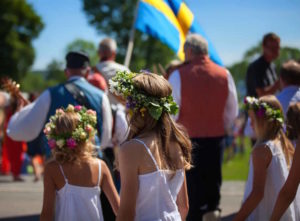Midsummer, an observation of the longest day of the year, is celebrated in each of the Scandinavian countries. Originally a pagan holiday, Midsummer is celebrated on the day of John the Baptist and is now held on the weekend closest to the summer solstice.


In Sweden the celebration takes place around a maypole that is trimmed with garlands of flowers. The word majstang (maypole) has nothing to do with the month of May. The custom att maja means to decorate with green leaves and branches, and at midsummer this is done freely. The maypole is raised on an open grassy area and the celebrants join hands and dance around it to tunes played on an accordion or fiddle.
In Finland everyone goes to their favorite lake shore where they build a bonfire, which is lit at midnight, and they dance. Since Midsummer was originally a pagan holiday, a number of superstitions are associated with the celebrations. It is very important to have birch in the house to guarantee future happiness. The Finns also hang birch wreaths on their cows’ horns to protect them. When the cows return home in the evening, the wreath becomes part of their meal.
In Norway and Denmark Midsummer is also known as Sankt Hans Aften and is celebrated on the eve of John the Baptist Day.

In Norway customs date back to pagan times when tribute was paid to the powers of the sun god with bonfires signifying the defeat of darkness. Often there is a procession that begins in the early evening that is led by a musician. It is a tradition to light a bonfire and to dance. Hot dogs, or pølser, are popular Midsummer fare around the fire. On this evening the magic creatures such as trolls and huldurs are invisible partners in the merrymaking.
In Denmark bonfires are also an important part of the celebration. Danes gather for a picnic, and after dark a bonfire with an effigy of a witch on top is set ablaze. A rocket-like firecracker is concealed in the witch’s clothing which, upon ignition, represents the witch’s return to Bloksbjerg, a mountain in the Black Forest and the home of the devil.
Today’s Midsummer celebrations feature traditions that anyone can incorporate. One of the most popular is creating a flower crown to wear! These wreaths represent rebirth and fertility and are worn by everyone, regardless of age or gender identity. They are traditionally made using whichever plants and branches you can find – but the options are endless. Because of the crowns and the iconic maypole, Swedish Midsommar has become one of the most well known solstice traditions around the world. Click here for extra flower crown tips and tricks!

Outdoor dining is a hallmark of Midsummer celebrations. The entire holiday is marking the longest day of the year, a whole 24 hours in some Northern countries, and taking advantage of that light and summer sun is the essence of Midsummer. The menu is flexible, but should highlight seasonal fruits and vegetables. We’ve put together a suggested Midsummer menu to inspire your table:
Our Splendid Midsummer Menu
Most ingredients available in our old world meat market and online!
- Matjes sill (herring)
- Grilled fish
- Boiled new potatoes with fresh dill
- Cold cucumber salad
- Spread of cheeses
- Wasa crisp bread, cardamom bread or limpa
- Swedish “Midsommar” Cake with strawberries (Click here for the recipe… )
Creating a Midsummer Atmosphere
- Decorate your table with wildflowers, wooden maypoles and Nordic flags
- Learn a ring dance and dance around your maypole or simply your yard
- Fill the air with Scandinavian music!
Create your own Midsummer celebration with a little help from Ingebretsen’s! We’ve gathered items that will inspire and enhance any summer solstice event.